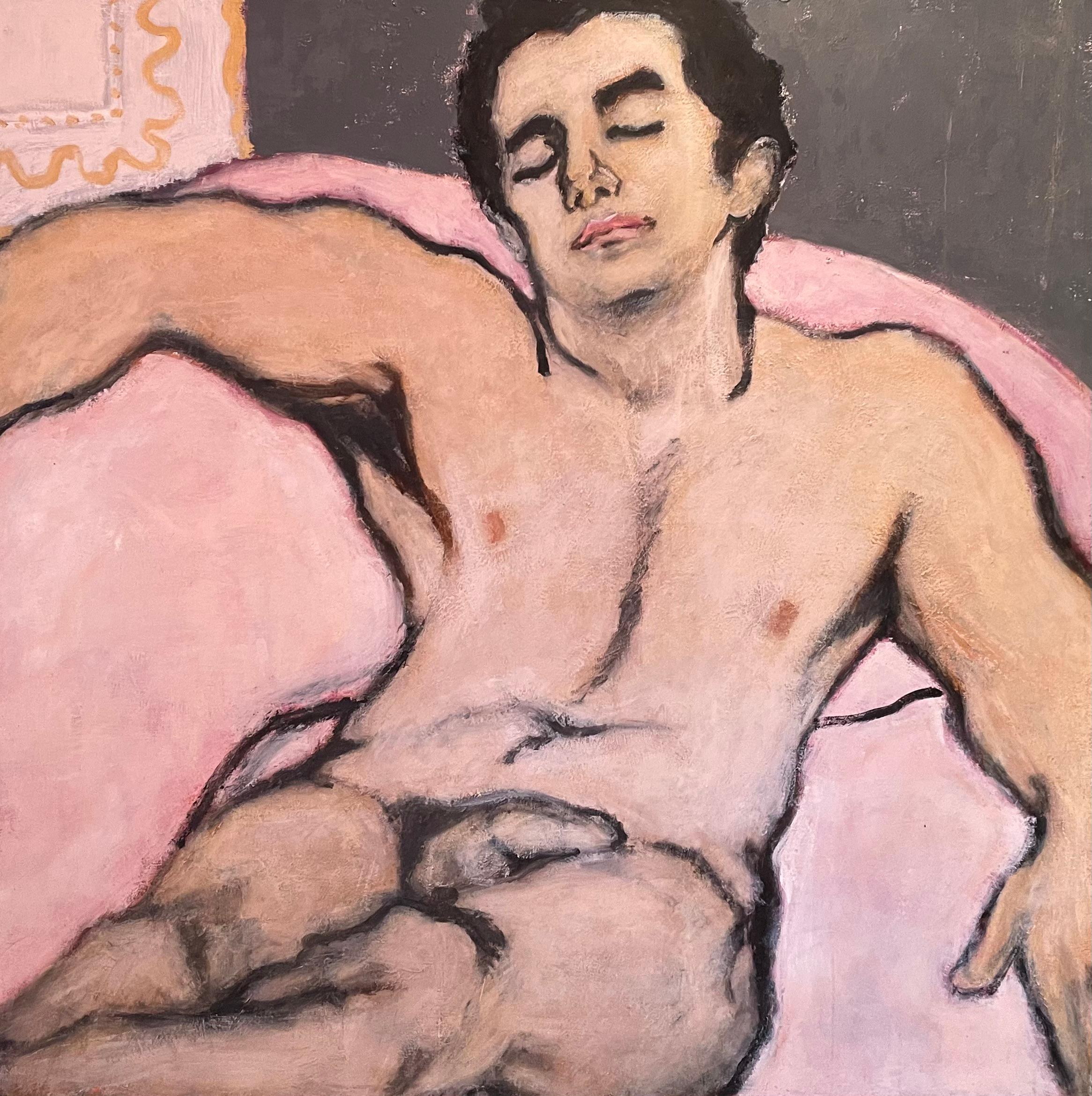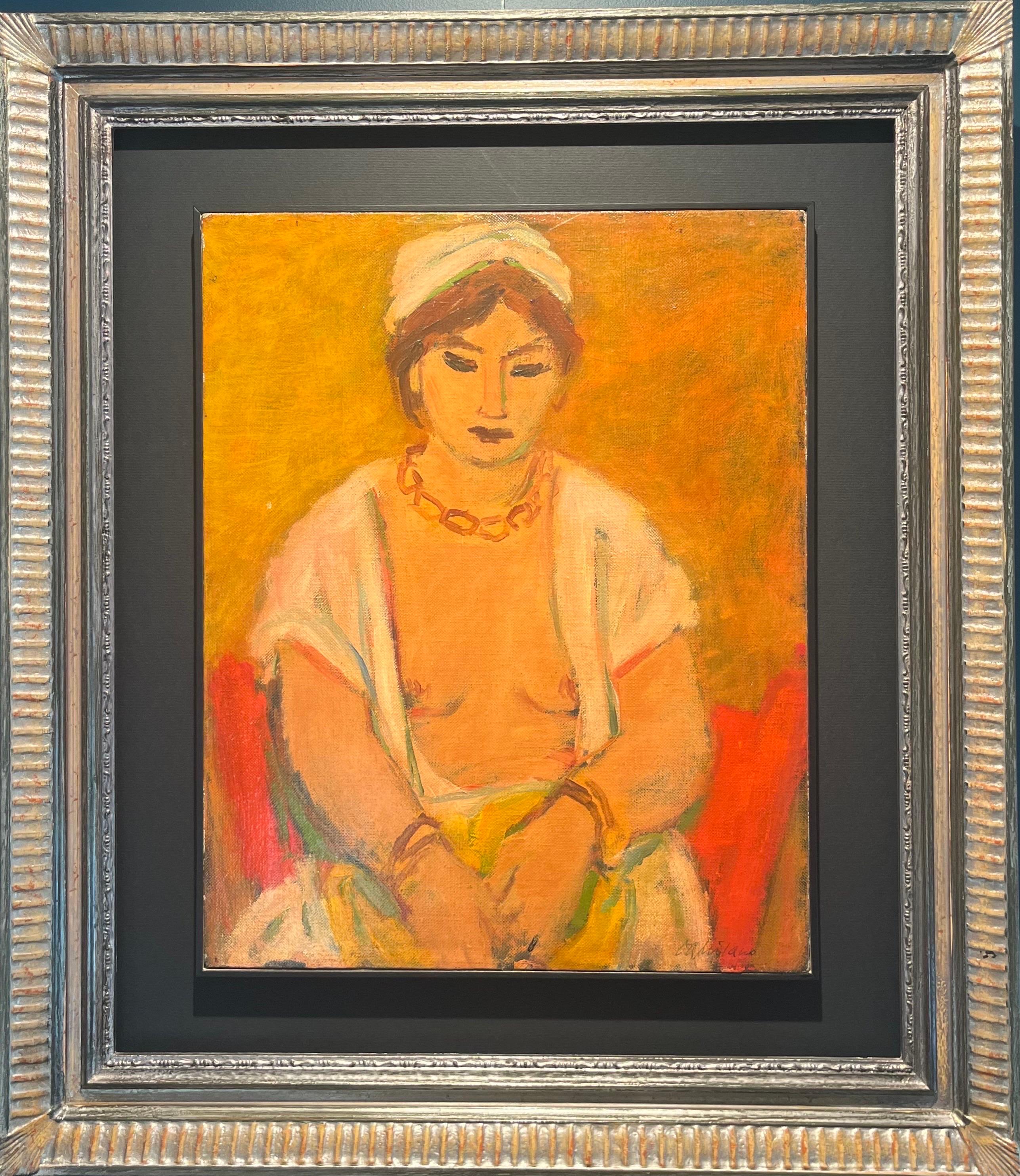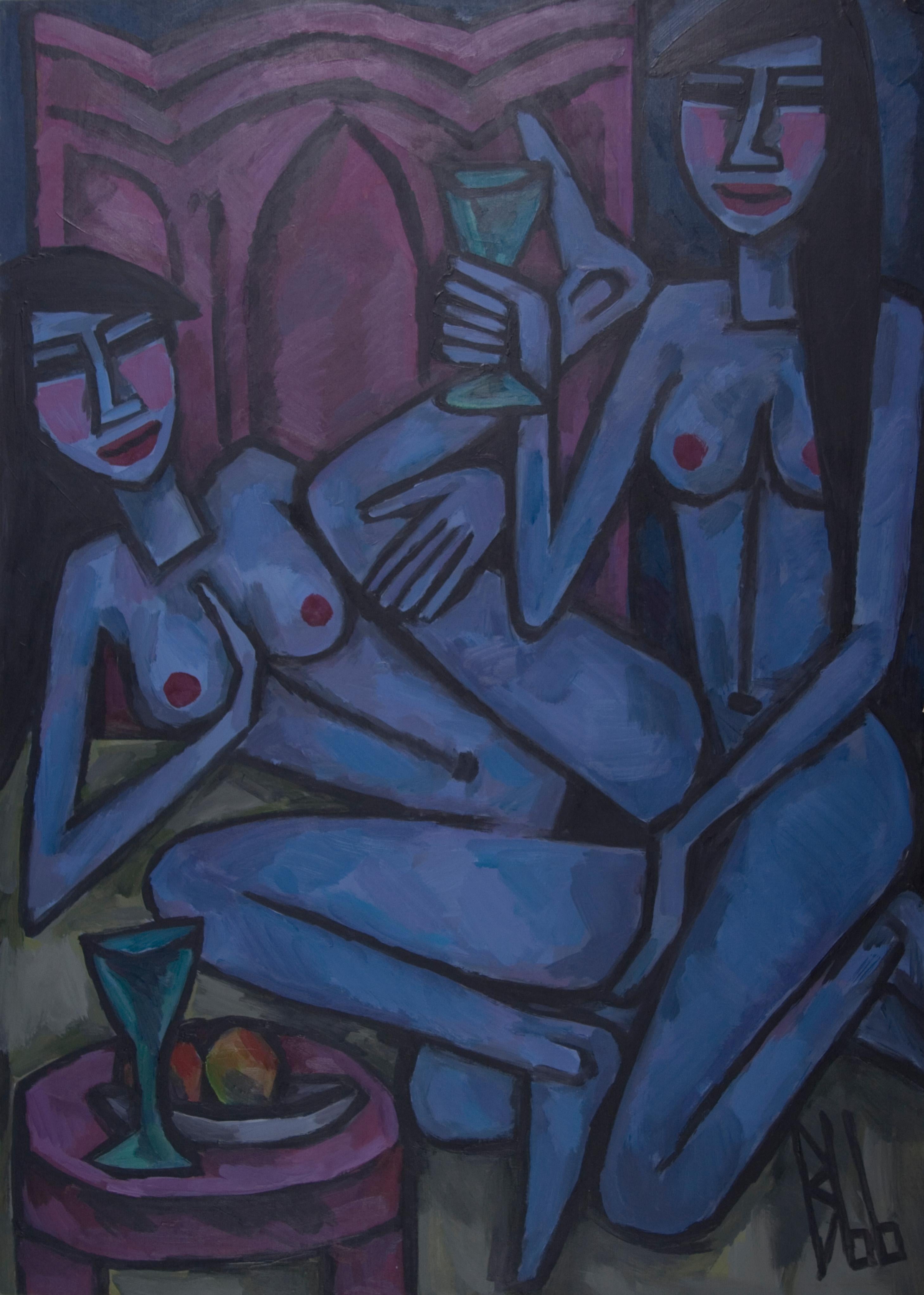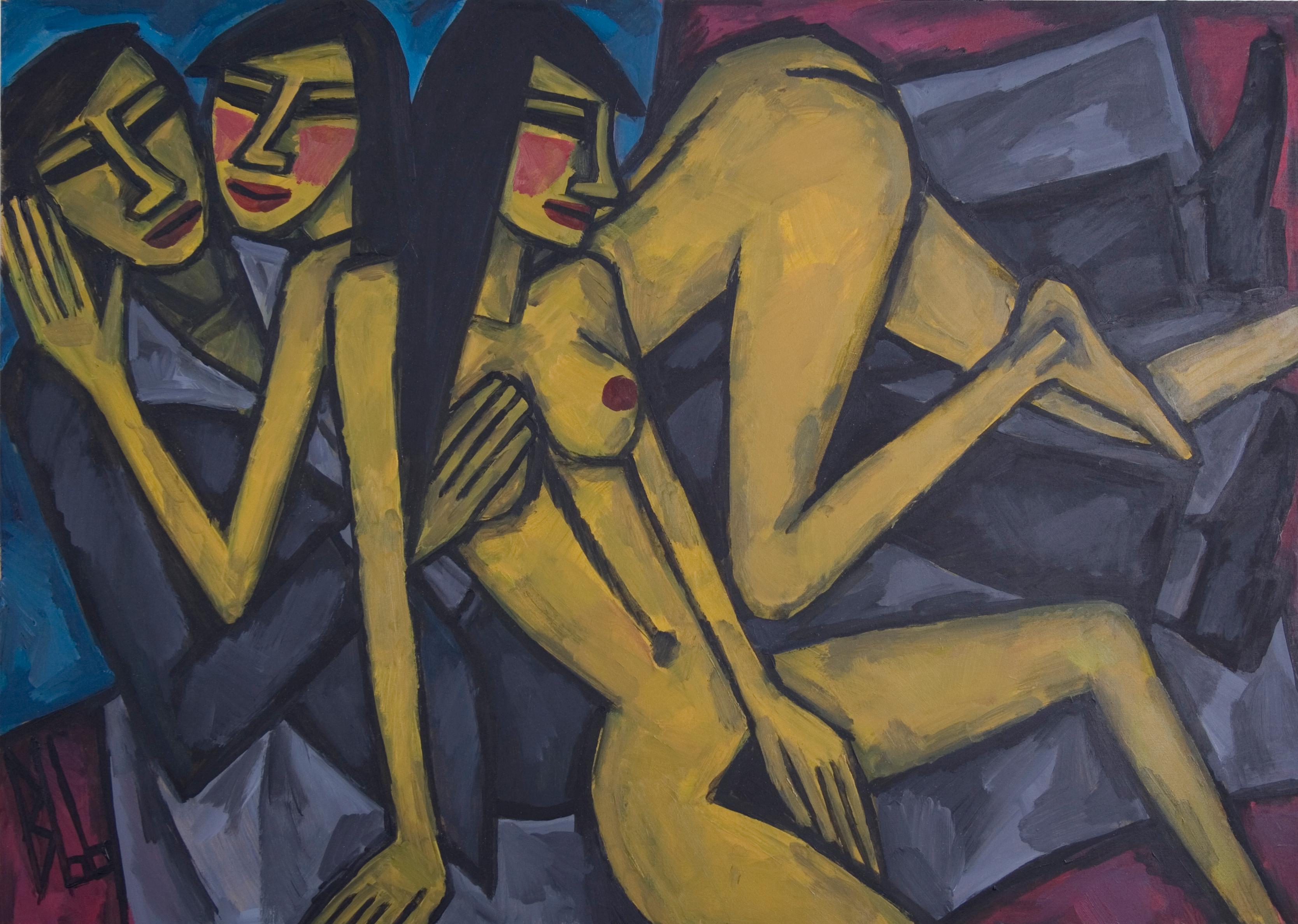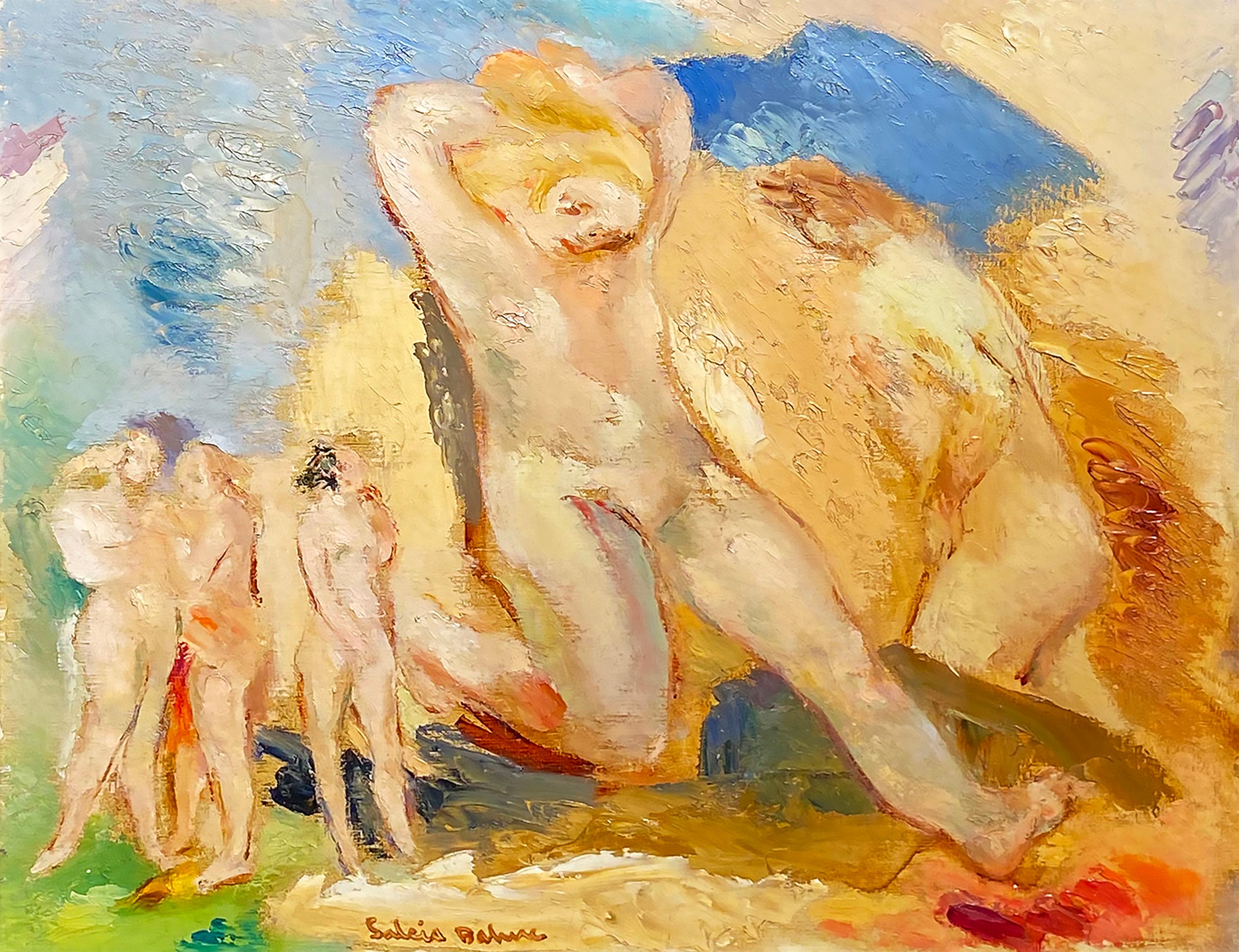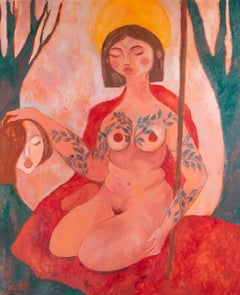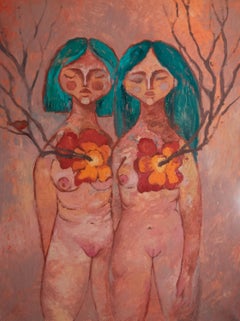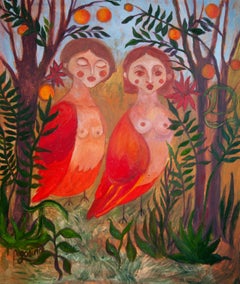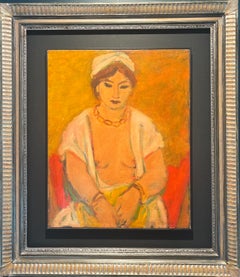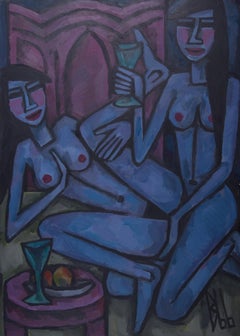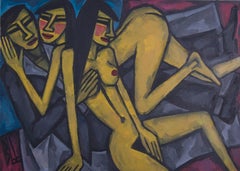Items Similar to Contemporary Figurative Original Painting "I need your friendship so much"
Want more images or videos?
Request additional images or videos from the seller
1 of 23
Dasha PogodinaContemporary Figurative Original Painting "I need your friendship so much" 2022
2022
About the Item
ABOUT THE ARTWORK
The painting "I Need Your Friendship So Much" portrays two figures in a tranquil, introspective state, bound together by a silent understanding. The warm, earthy tones that dominate the piece—soft ambers, muted reds, and gentle browns—evoke a sense of comfort and familiarity. The figures' poses and the intertwining of their forms suggest a deep bond that speaks to the fundamental human need for connection and companionship. The painter's brushwork is tender and deliberate, with each stroke adding to the narrative of shared experiences and mutual support. This artwork is a testament to the profound simplicity found within the complex emotions of friendship.
PERICHORESIS SERIES
In her series of works, Dasha uses the term "perichoresis" (Dr.-Greek περιχώρησις - "interpenetration"), a theological term meaning the mutual penetration of divine parts into each other, for the title to describe a unique union that does not imply mixing or merging, but emphasizes an inseparable and inseparable unity.
In her work, Daria explores the theme of a new sexuality, deliberately choosing a term from theological treatises for her series of works. With this provocative gesture, she protests against the dictates of religion, the manipulation and pessimization of human sexual expression and corporeality by the church. "Perichoresis" for her is a beautiful and complex term describing the fusion of the divine. Having grown up in the Protestant tradition within Orthodox society, Daria states the separation of sexuality from divinity common in all these religions, while she sees sexuality as the brightest manifestation of divinity, beauty and sublimity.
The artist notes that Christian culture has invested the image of the female body with a narrative of pornographic tension, while at the same time presenting paradise before the fall as a sexual paradise, a Garden of earthly pleasures. For the artist, sexual paradise is a safe environment, complete trust, acceptance, an opportunity to open up and discover the Other, an opportunity to learn to be loved and to love. An environment where fusion does not dissolve in the other person, but on the contrary strengthens the individuality of each person and enriches each other.
Thus the artist through the term "perichoresis", which means interpenetration, fusion of individualities and even occurs in Christian treatises as a round dance of love, reminds that the division into high and low in love is artificial, and overcoming this division can make life more beautiful. The characters in her paintings are immersed in the enigmatic space of love, and sometimes ironic scenes that balance the degree of sublimity with encounters with anthropomorphic partners.
- Creator:Dasha Pogodina (1992, Ukrainian)
- Creation Year:2022
- Dimensions:Height: 45.28 in (115 cm)Width: 37.41 in (95 cm)Depth: 0.79 in (2 cm)
- Medium:
- Movement & Style:
- Period:
- Condition:
- Gallery Location:Zofingen, CH
- Reference Number:1stDibs: LU2203212720862
Dasha Pogodina Ukrainian artist, based in Switzerland. Paintings are in private collections in the USA, South Korea, Italy, Great Britain, Germany, and Switzerland. Exhibitions
2022 Solo Exhibition Stärke und Verletzlichkeit / Escape Vide - Thun, Switzerland
2022 Group exhibitions In Ukraine / ZRC - Ljubljana, Slovenia
2018 Group exhibitions Room of my Minds, Ukraine
2017 Group exhibitions Garden as an Art, Kyiv, Ukraine
2014 Group exhibitions Gift of Volhvs Severodonetsk, Ukraine
2013 Group exhibitions Fragment of Life, Luhansk, Ukraine
2012 Collaborate Project Light of Hearts, Luhansk Ukraine Dasha Pogodina about her art New sexuality and personal integrity - are the basic areas of search in my artistic practice.
In my practice, I problematize the ideal of the metamodern world with its total moderation and the desire to return to high ideals and values. As an artist, I concentrate on the nature of the corporeal, I perceive the body as a membrane reflecting me into this world and communicating the world to me. In search of answers, I enter into dialogue with the body-sensory lexicon of Kiki Smith and Paula Modersohn Becker and also find support in the sublime physicality of the early Gothic of the 13th century from Giotto, unencumbered by the tension of formal anatomy. My works are filled with color, and ethnic decoration and are illustrative at the same time. This turns my paintings into light, at first glance, stories, which, however, do not call the viewer to cold contemplation, but, on the contrary, open up the opportunity to safely return to their secret “I”.
I use the space of naive archetypal images, creating a safe haven from aggressive modernity, with the opportunity to dive into the psychological depths of my own worldview. I build into my paintings the mechanics of oscillation of naivety and mockery, trust and cynicism, chastity and debauchery, strength and kindness, as a manifesto of courage to be vulnerable and herbivorous in a world where food chains still exist.
About the Seller
5.0
Platinum Seller
These expertly vetted sellers are 1stDibs' most experienced sellers and are rated highest by our customers.
Established in 2019
1stDibs seller since 2022
390 sales on 1stDibs
Typical response time: 1 hour
- ShippingRetrieving quote...Ships From: Zofingen, Switzerland
- Return PolicyA return for this item may be initiated within 7 days of delivery.
Authenticity Guarantee
In the unlikely event there’s an issue with an item’s authenticity, contact us within 1 year for a full refund. DetailsMoney-Back Guarantee
If your item is not as described, is damaged in transit, or does not arrive, contact us within 7 days for a full refund. Details24-Hour Cancellation
You have a 24-hour grace period in which to reconsider your purchase, with no questions asked.Vetted Professional Sellers
Our world-class sellers must adhere to strict standards for service and quality, maintaining the integrity of our listings.Price-Match Guarantee
If you find that a seller listed the same item for a lower price elsewhere, we’ll match it.Trusted Global Delivery
Our best-in-class carrier network provides specialized shipping options worldwide, including custom delivery.More From This Seller
View AllMy main enemy. Contemporary Figurative Oil Painting. Woman Power Symbolism. Red
Located in Zofingen, AG
ABOUT THE ARTWORK
"My Main Enemy" presents a compelling narrative of self-reflection and inner turmoil. The canvas speaks volumes through the bold imagery of a woman holding her hea...
Category
2010s Expressionist Nude Paintings
Materials
Canvas, Oil
You rise me up
Located in Zofingen, AG
ABOUT THE ARTWORK
"Rising in Unity," this poignant artwork, explores themes of kinship, growth, and the nurturing aspect of nature. The two figures stand as mirror images, their sha...
Category
2010s Contemporary Figurative Paintings
Materials
Oil, Canvas
$708 Sale Price
54% Off
Sirens Art Modern Woman Nude, Bird Woman, canvas, oil - Garden guards 90x75 cm
Located in Zofingen, AG
ABOUT THE ARTWORK
The painting titled "Garden guards" is an evocative fusion of human and avian forms, a surreal ode to the guardians of a mystical orchard. The two central figures, ...
Category
2010s Impressionist Figurative Paintings
Materials
Oil, Canvas
Nude Woman Painting, Modern Art, canvas, oil - PLEASURE - 24x32in (80*60cm)
Located in Zofingen, AG
ABOUT THE ARTWORK
"Nude Woman Painting, Modern Art" captures the timeless grace of the human form through a modern lens. This painting reveals the delicate interplay of light and sha...
Category
2010s Impressionist Figurative Paintings
Materials
Oil, Canvas
Nude Woman Naive Modern Art, canvas, oil - WARRIOR - 28x32in (80*75) cm
Located in Zofingen, AG
ABOUT THE ARTWORK
"WARRIOR" is a vivid portrayal of strength and motion, a captivating tableau where mythology meets the modern spirit.
The figure, poised with a lance, exudes a se...
Category
2010s Impressionist Figurative Paintings
Materials
Canvas, Oil
$1,002 Sale Price
28% Off
Free Shipping
FLORA
Located in Zofingen, AG
ABOUT THE ARTWORK
Entitled "FLORA," this painting is a serene contemplation of nature's restorative embrace. The subject, a solitary figure melded with avian elements, sits peaceful...
Category
2010s Impressionist Nude Paintings
Materials
Canvas, Oil
$752 Sale Price
20% Off
You May Also Like
'Young Man in Repose' by Podlach - Large Figurative Nude Young Man Painting
By Betsy Podlach
Located in Carmel, CA
"Man in Repose" is a captivating painting by Betsy Podlach that effortlessly captures a serene and tranquil moment. The artwork portrays a nude, young, and handsome man with closed e...
Category
21st Century and Contemporary Expressionist Nude Paintings
Materials
Oil, Canvas
$13,750 Sale Price
44% Off
Free Shipping
"Odalisque yellow" Oil , cm. 40 x 50 1937 free shipping
By Giulio da Milano
Located in Torino, IT
Odalisque ,yellow,orange, orient
Giulio DA MILANO (Nizza, 1895 - Torino, 1990)
Giulio Da Milano was a Giacomo Grosso's disciple and he was very close to the artists that used to patronize La Coupole de Montparnasse (from Kisling to Pascin, from Derain to Vlaminck). He is considered one of most representative exponents of the Turin’s artistic scene in the ‘30s-‘40s, close to the Gruppo dei Sei. His works can be found in the following museums:
Turin, Modern Art Gallery...
Category
1930s Expressionist Figurative Paintings
Materials
Canvas, Oil
$6,020 Sale Price
20% Off
Two ladies with glasses
Located in Wien, 9
Gurami Hagemann was born in Tiblissi in Georgia in 1945. At the age of 15 he received his diploma in painting. From 1965 to 1971 he attended the Art Academy in Tiblissi. In 1993 he r...
Category
20th Century Expressionist Nude Paintings
Materials
Canvas, Oil
Act of love
Located in Wien, 9
Gurami Hagemann was born in Tiblissi in Georgia in 1945. At the age of 15 he received his diploma in painting. From 1965 to 1971 he attended the Art Academy in Tiblissi. In 1993 he r...
Category
20th Century Expressionist Nude Paintings
Materials
Canvas, Oil
$2,839
"Aquarius" Oil Painting 31.5" x 51" inch by Sergey Dolmatov
Located in Culver City, CA
"Aquarius" Oil Painting 31.5" x 51" inch by Sergey Dolmatov
Year: 2014
Category
21st Century and Contemporary Expressionist Figurative Paintings
Materials
Canvas, Oil
Nudes
Located in Missouri, MO
Nudes
By. Salcia Bahnc (Polish, American, 1898-1976)
Signed Lower Middle
Unframed: 14 x 18 inches
Framed: 23 x 26 inches
Painter, illustrator, printmaker, teacher. Born in Dukla, Poland. Though she was born in Dukla, a town in south-eastern Poland, she moved to Prsemysl, one of the largest and most ancient cities of southern Poland, at a young age. Her mother was reportedly descended from the "Van Ast" family, a Dutch dynasty that produced several artists, including Balthasar van der Ast (1593/4 - 1657). According to one art historian she came to New York at the age of five (c. 1903), and another, at the age of eight (c. 1906).
Her family was Jewish and reportedly quite wealthy. Why they would have left imperial Austria, under whose sovereignty either of her proposed birth cities were under, is unknown. However, while these areas did not suffer the pogroms typical in neighboring imperial Russia, the Austro-Hungarian empire had become much more anti-Semetic, which may have hasten there departure. How, according to one source, they ended up living in the Jewish ghetto of New York is extremely puzzling. Did they loose their wealth to some business disaster? Where they forced to leave it behind? Was there some familial tragedy? We may never know.
In her youth she lived first in New York City and then in Boston, Massachusetts, where her family had relatives. It is reported that when she was in fourth grade she was found to be so competent in drawing that for the next two years she taught a drawing class after school for the other children. In Boston, Bahnc's mother eventually remarried and moved the family to Chicago where the young artist was primarily raised.
In Chicago she worked during the days as a sales clerk in a department store. At night she put herself through school at the School of the Art Institute of Chicago (SAIC) and taught at her former alma mater after her graduation during the years 1923-1929. She also studied at the Chicago Academy of Fine Art. She took up design work and began exhibiting painted silk creations at a private Chicago gallery (probably Thurber, see below). The first museum exhibitions she is known to have participated in were held at the Art Institute of Chicago. During this period she became known for her portraits.
Originally a resident alien, she was naturalized at the district court of Chicago, Illinois in July of 1913. In 1920 she lived on East Ontario Street in Chicago in a neighborhood filled with art studios and artists, including James Allen Saint-John (1872-1957), Paul Bartlett (1881-1965), Pauline Palmer (1867-1938), and George Ames Aldrich (1872-1941). It is in Chicago that she saw her greatest success as an artist. In 1927, Chicago art dealer Chester H. Johnson said of her work: "The Art of Salcia Bahnc is a sincere manifestation of the spirit we know as 'Modernism' . . . . . . She is the spirit of the Age, not its Fashion." Local reviewers agreed, one going as far to say that her exhibition was " . . . the most interesting one man show by a young artist that has ever been presented to Chicago, and I keep telling myself that New York will get her if we don't watch out."
She was apparently a favorite and friend of art critic Clarence Joseph Bulliet (1883-1952), who authored a number of books and articles that praised Bahnc's work. Bulliet was central in introducing and popularizing modern art in the mid-western United States. In his book Apples and Madonnas: Emotional Expression in Modern Art (1935) he called Bahnc a "A thorough Expressionist." A year later in his book The Significant Moderns and Their Pictures (1936) he noted that one of her paintings of a nude was ". . . powerful in its elemental brutality."
During this period other critics reported positively on the work she was producing. Ida Ethelwyn Wing reported in a volume of the Delphian Text (1930) that Bahnc, was without doubt, ". . . the most vigorous and intensively original of the American Expressionists." Paul Masserman and Maxwell Baker said of her in their work The Jews come to America (1932) that she was part of a group of artists that were "Chief among modern Jewish painters. . . "
Salcia Bahnc traveled back and forth to Europe during the late 1920s and into the 1930s, a period when she faced the rise of totalitarianism. She wrote about this fact to a fellow artist to whom she commented " . . . about the difficult art scene in Paris . . . . . . and the growing power of fascism." In 1930 she was maintaining a studio in New York City at 1218 East 53rd Street and a residence in Brooklyn, Long Island. She returned to France where she married a French citizen and writer named Eugene Petit (b. 1901) and bore a son there named Alain Petit (b. 1934). She again returned to the United States in November of 1937 and traveled back to France after a brief stay in America. During her stay she continued to exhibit in Chicago, where Quest Galleries gave her a solo show.
Like so many ex-patriot authors and artists who were living in Paris, she found herself trapped in France (first in Paris, then in Mayenne) following the German invasion in 1940. Being of Jewish extraction the situation could prove to be quite dangerous if she were reported or discovered by German authorities. She and her husband were able to obtain passports and escape to Portugal where in August of 1941 they boarded the S. S. Escambion to return to America.
In 1940, American Export Lines, owners of the Escambion, discontinued its normal Mediterranean routes and placed their ships into service sailing from Lisbon, Portugal to New York City. Over the next two years (1940 - 1941) their ships played an important role in transporting thousands of people who were trying to escape the Nazi regime before America's own entry into World War II. One survivor, Ludwig Lowenberg, who sailed on the Escambion on the same day that Bahnc did, reported the ordeal his family endured getting to Lisbon to his own descendants:
"[The family] received their American visa on May 28, 1941, only three days before the U.S. consulate in Stuttgart closed for the duration of World War II. They left Berlin on June 23, 1941, traveling for 27 hours on a locked train to Paris. There they were forced to spend an additional night in the locked train until their coach was attached to a train headed for San Sebastian in Spain. After an overnight hotel stay in San Sebastian, the train (now no longer locked) continued to Lisbon. All in all it took six days from Berlin to Lisbon. They remained for four weeks in Lisbon until they embarked on the Excambion for New York."
Bahnc had given up her citizenship during her time in France and was forced to reapply for naturalization once again upon her return. She was living in New York City at 101 West 85th Street when she was re-naturalized in April of 1947.
Exactly how much of her artwork was lost in Europe is not known. Clearly, she would not have been able to bring much, if anything, with her during her escape. One writer had noted that between 1930 and 1934 she had worked hard to prepare a large group of new works for a show in Paris. Between those, and what she would have produced during the next six years, the actual amount of the loss might have been staggering. Bahnc's 1942 exhibition with Julio de Diego included works recalling the suffering going on in Europe. One work in the exhibition was a portrait of the painter Katherine Dudley, who, at the time, was reportedly interned near Paris.
In the later years of her career she worked extensively as a teacher and illustrator of children's books. In 1950 she taught at the Evanston Art Center, where she lead a demonstration in portrait painting. She authored or illustrated a number of works during and after World War II, including: The House in the Tree and Other Stories of Places, People and Things (1941); Claude Of France: The Story Of Debussy For Young People (1948); Time for Poetry (1951); Hidden Silver (1952); From Many Lands - The Children's Hour, Volume 9 (1969); and That Boy (no date). She returned to teach at the School of the Art Institute of Chicago during 1943-44 and 1947-53; and taught later at the Garrison Forest School in Garrison, Maryland, from 1955-57.
Bahnc was known to have exhibited widely, both in Europe and in America. Her known lifetime exhibitions include: The Art Institute of Chicago, Chicago, IL, 1919-29, 1942 (The 53rd Annual; and Room of Chicago Art: Exhibition of Paintings by Salcia Bahnc and Julio de Diego), 1943; Chicago Architectural...
Category
20th Century Expressionist Nude Paintings
Materials
Oil, Canvas
Price Upon Request
Recently Viewed
View AllMore Ways To Browse
The Human Form Divine
Pornography Artwork
Oil Priests
Parisian Cafe Oil Painting
Portraits Of Fishermen
Surreal Painting And Food
Cheval Artist
Dior Lily
Finger Pointing
Leighton Gallery
Miniature Painting Ship
Oil Painting Cavalier
Old Strasbourg
Philip Horse
Signed Maurice Denis
Edward Francis Wells
Italian Romance Painting
Matador And Bull
